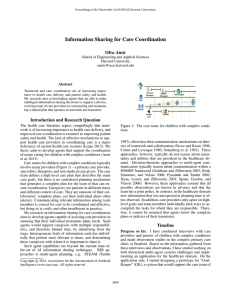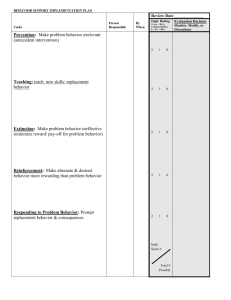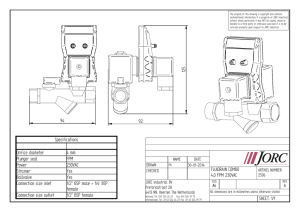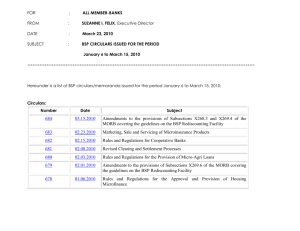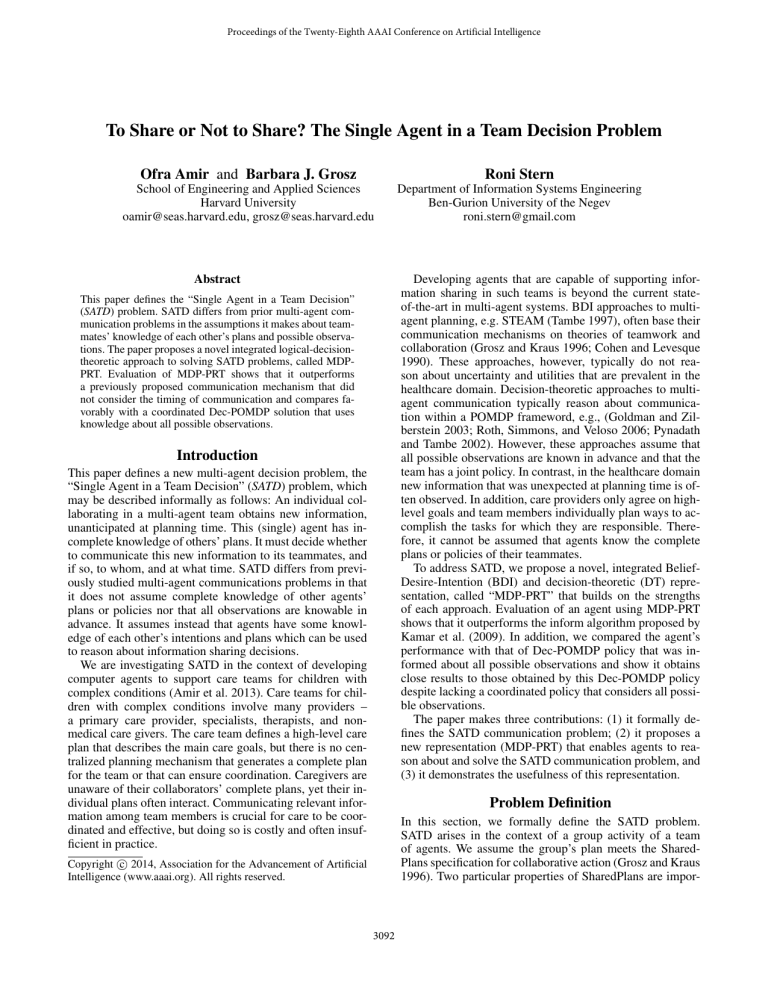
Proceedings of the Twenty-Eighth AAAI Conference on Artificial Intelligence
To Share or Not to Share? The Single Agent in a Team Decision Problem
Ofra Amir and Barbara J. Grosz
Roni Stern
School of Engineering and Applied Sciences
Harvard University
oamir@seas.harvard.edu, grosz@seas.harvard.edu
Department of Information Systems Engineering
Ben-Gurion University of the Negev
roni.stern@gmail.com
Abstract
Developing agents that are capable of supporting information sharing in such teams is beyond the current stateof-the-art in multi-agent systems. BDI approaches to multiagent planning, e.g. STEAM (Tambe 1997), often base their
communication mechanisms on theories of teamwork and
collaboration (Grosz and Kraus 1996; Cohen and Levesque
1990). These approaches, however, typically do not reason about uncertainty and utilities that are prevalent in the
healthcare domain. Decision-theoretic approaches to multiagent communication typically reason about communication within a POMDP frameword, e.g., (Goldman and Zilberstein 2003; Roth, Simmons, and Veloso 2006; Pynadath
and Tambe 2002). However, these approaches assume that
all possible observations are known in advance and that the
team has a joint policy. In contrast, in the healthcare domain
new information that was unexpected at planning time is often observed. In addition, care providers only agree on highlevel goals and team members individually plan ways to accomplish the tasks for which they are responsible. Therefore, it cannot be assumed that agents know the complete
plans or policies of their teammates.
To address SATD, we propose a novel, integrated BeliefDesire-Intention (BDI) and decision-theoretic (DT) representation, called “MDP-PRT” that builds on the strengths
of each approach. Evaluation of an agent using MDP-PRT
shows that it outperforms the inform algorithm proposed by
Kamar et al. (2009). In addition, we compared the agent’s
performance with that of Dec-POMDP policy that was informed about all possible observations and show it obtains
close results to those obtained by this Dec-POMDP policy
despite lacking a coordinated policy that considers all possible observations.
The paper makes three contributions: (1) it formally defines the SATD communication problem; (2) it proposes a
new representation (MDP-PRT) that enables agents to reason about and solve the SATD communication problem, and
(3) it demonstrates the usefulness of this representation.
This paper defines the “Single Agent in a Team Decision”
(SATD) problem. SATD differs from prior multi-agent communication problems in the assumptions it makes about teammates’ knowledge of each other’s plans and possible observations. The paper proposes a novel integrated logical-decisiontheoretic approach to solving SATD problems, called MDPPRT. Evaluation of MDP-PRT shows that it outperforms
a previously proposed communication mechanism that did
not consider the timing of communication and compares favorably with a coordinated Dec-POMDP solution that uses
knowledge about all possible observations.
Introduction
This paper defines a new multi-agent decision problem, the
“Single Agent in a Team Decision” (SATD) problem, which
may be described informally as follows: An individual collaborating in a multi-agent team obtains new information,
unanticipated at planning time. This (single) agent has incomplete knowledge of others’ plans. It must decide whether
to communicate this new information to its teammates, and
if so, to whom, and at what time. SATD differs from previously studied multi-agent communications problems in that
it does not assume complete knowledge of other agents’
plans or policies nor that all observations are knowable in
advance. It assumes instead that agents have some knowledge of each other’s intentions and plans which can be used
to reason about information sharing decisions.
We are investigating SATD in the context of developing
computer agents to support care teams for children with
complex conditions (Amir et al. 2013). Care teams for children with complex conditions involve many providers –
a primary care provider, specialists, therapists, and nonmedical care givers. The care team defines a high-level care
plan that describes the main care goals, but there is no centralized planning mechanism that generates a complete plan
for the team or that can ensure coordination. Caregivers are
unaware of their collaborators’ complete plans, yet their individual plans often interact. Communicating relevant information among team members is crucial for care to be coordinated and effective, but doing so is costly and often insufficient in practice.
Problem Definition
In this section, we formally define the SATD problem.
SATD arises in the context of a group activity of a team
of agents. We assume the group’s plan meets the SharedPlans specification for collaborative action (Grosz and Kraus
1996). Two particular properties of SharedPlans are impor-
Copyright c 2014, Association for the Advancement of Artificial
Intelligence (www.aaai.org). All rights reserved.
3092
rithm of Kamar et al. (2009). Table 1 shows the average
utility achieved by the agents in experiments with different communication costs. The MDP-PRT agent outperforms
the PRT agent across all configurations and communication
costs. This is because the MDP-PRT considers the possibility of communicating at a later time, while the PRT inform
algorithm is myopic.
tant: plans, which decompose into constituent tasks, may
be only partially specified and agents do not know the details of constituent tasks for which they are not responsible.
An instance of the SATD problem is represented by a tuple
hai , A−i , bSP , V, o∗ , ϕcomm , Ci.
ai is the agent that observes new information. o∗ is the
new information ai obtained. A−i are the other agents that
are part of the team. bSP is ai ’s beliefs about the SharedPlan
of the team (ai knows its own plans but he is uncertain about
others’ plans). V is the utility function; its value is the utility
of completed constituent tasks. We assume a fully cooperative setting and all agents share the same utility. ϕcomm is a
function that produces a modified b0SP under the assumption
that the agents in A−i (or a subset of them) are informed
about o∗ . C is the cost of communicating o∗ . SATD is the
problem of ai determining whether to communicate o∗ to
agents in A−i and if so, at what time.
Comm. Cost
PRT
MDP-PRT
5
67.67
77
10
65.17
75.57
20
60.17
72.83
30
55.17
70.03
Table 1: Average utility for PRT Inform and MDP-PRT.
Key aspects of SATD are that agents cannot anticipate a1
observing o∗ nor form a coordinated policy. This limits the
possible utility achievable in SATD, as a coordinated policy that takes into account knowledge of possible observations during planning time can lead to better performance.
To evaluate the loss in utility as a result of this missing
knowledge, we compare the MDP-PRT with a joint policy generated using a Dec-POMDP that is knowledgable of
the possible observations at planning time. As expected, the
Dec-POMDP always performs better as a result of its additional information at planning time (see table 2). However,
the average utility achieved by MDP-PRT is still within 15%
of the optimal utility.
Approach
This section proposes a solution to the 2-agent SATD
problem ha1 , a2 , bSP , V, o∗ , ϕcomm , Ci, where an agent a1
learns new information o∗ and needs to reason whether and
when to communicate o∗ to a2 . To solve the 2-agent SATD
communication problem, we use an MDP in which the states
explicitly represent a1 ’s beliefs about a2 ’s plans. The choice
of representation for the agent’s beliefs bSP is key, as it affects the way bSP can be revised and therefore the computational efficiency of solving the MDP. Our approach uses
a Probabilistic Receipe Tree (PRT) (Kamar, Gal, and Grosz
2009) to represent bSP .
In the MDP-PRT hA, S, R, T r, s0 i, A includes two actions inform (communicating o∗ ) and ¬inform (not communicating o∗ ). Each state in S encompasses a1 ’s beliefs
about a2 ’s plans (i.e., the PRT corresponding to bSP ). We
denote a state by bSP . The initial state bSP 0 corresponds to
a1 ’s initial beliefs about the SharedPlan. The reward function is a function of V and C: the reward for a state bSP
is the value of the constituent tasks completed in the last
time step minus the cost of communication if a1 chose to inform a2 . The transition function, T r(bSP 0 , a, bSP ), defines
the probability of reaching state bSP 0 , when taking action
a in state bSP . a1 ’s belief may change for two different reasons. First, if a1 communicates o∗ to a2 , then bSP changes to
ϕcomm (bSP , o∗ ). Second, as a2 executes actions in its constituent plans, a1 may “observe” a2 ’s actions or results of
those actions and learn more about a2 ’s plans. To reflect this
reasoning, we define an additional function, ϕobs (bSP ). This
function takes as input bSP and returns the set of next exnext
pected beliefs bnext
SP and their probabilities Pr(bSP ).
An optimal single agent communication policy can be
computed using any MDP solver, e.g. value iteration algorithm used in our implementation.
Comm. Cost
Dec-POMDP
MDP-PRT
5
101.8
100.52
10
101.46
99.08
25
100.2
94.38
50
98.13
87.5
Table 2: Average utility for Dec-POMDP and MDP-PRT.
Acknowledgements
The research reported in this paper was supported in part by
a grant from the Nuance Foundation.
References
Amir, O.; Grosz, B. J.; Law, E.; and Stern, R. 2013. Collaborative
health care plan support. In Proceedings of the 12th international
conference on Autonomous agents and multi-agent systems, 793–
796.
Cohen, P., and Levesque, H. 1990. Intention is choice with commitment. Artificial intelligence 42(2):213–261.
Goldman, C. V., and Zilberstein, S. 2003. Optimizing information
exchange in cooperative multi-agent systems. In Proceedings of
the second international joint conference on Autonomous agents
and multiagent systems, 137–144.
Grosz, B., and Kraus, S. 1996. Collaborative plans for complex
group action. Artificial Intelligence 86(2):269–357.
Kamar, E.; Gal, Y.; and Grosz, B. 2009. Incorporating helpful
behavior into collaborative planning. In Proceedings of The 8th
International Conference on Autonomous Agents and Multiagent
Systems, 875–882.
Pynadath, D. V., and Tambe, M. 2002. The communicative multiagent team decision problem: analyzing teamwork theories and
models. Journal of Artificial Intelligence Research 16(1):389–423.
Roth, M.; Simmons, R.; and Veloso, M. 2006. What to communicate? execution-time decision in multi-agent POMDPs. Distributed
Autonomous Robotic Systems 7 177–186.
Tambe, M. 1997. Agent architectures for flexible practical teamwork. AAAI 97(1):997.
Results
We tested the MDP-PRT agent using a modified version of
the Colored Trails (CT) game used by Kamar et al. (2009).
The first experiment compared the performance of the MDPPRT agent with that of a PRT agent using the inform algo-
3093

